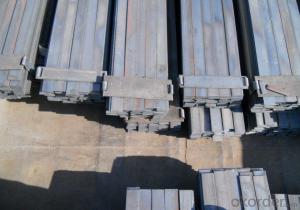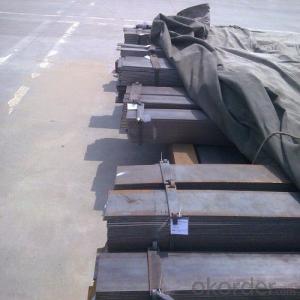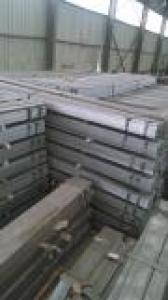Hot Rolled Flat Steel Bar in Grade Q235B
- Loading Port:
- Tianjin
- Payment Terms:
- TT OR LC
- Min Order Qty:
- 25 m.t.
- Supply Capability:
- 10000 m.t./month
OKorder Service Pledge
OKorder Financial Service
You Might Also Like
OKorder is offering high quality Flat Bar at great prices with worldwide shipping. Our supplier is a world-class manufacturer of steel, with our products utilized the world over. OKorder annually supplies products to European, North American and Asian markets. We provide quotations within 24 hours of receiving an inquiry and guarantee competitive prices.
Product Applications:
Flat Bars are ideal for structural applications and are widely used in the construction of buildings and bridges, and the manufacturing, petrochemical, and transportation industries.
Product Advantages:
OKorder's Flat Bars are durable, strong, and resist corrosion.
Main Product Features:
· Premium quality
· Prompt delivery & seaworthy packing (30 days after receiving deposit)
· Corrosion resistance
· Can be recycled and reused
· Mill test certification
· Professional Service
· Competitive pricing
Product Specifications:
Manufacture: Hot Rolled
Grade: Q195 – 235
Certificates: ISO, SGS, BV, CIQ
Length: 6m – 12m, as per customer request
Packaging: Export packing, nude packing, bundled
Chemical composition of Q235
Alloy No | Grade | Element(%) | ||||
C
| Mn
| S
| P
| Si
| ||
Q235
|
B
|
0.12—0.20 |
0.3—0.7 |
≤0.045 |
≤0.045
|
≤0.3
|
Physical properties of Q235
Alloy No | Grade | Yielding strength point(Mpa) | Tensile strength (Mpa) | Elongation after fracture(%) | ||||||
Thickness (mm) | Thickness (mm) | |||||||||
≤16 | >16--40 | >40--60 | >60--100 | ≤16 | >16--40 | >40--60 | >60--100 | |||
≥ | ≥ | |||||||||
Q235 |
B |
235 |
225 |
215 |
205 |
375--500 |
26 |
25 |
24 |
23 |
FAQ:
Q1: Why buy Materials & Equipment from OKorder.com?
A1: All products offered by OKorder.com are carefully selected from China's most reliable manufacturing enterprises. Through its ISO certifications, OKorder.com adheres to the highest standards and a commitment to supply chain safety and customer satisfaction.
Q2: How do you guarantee the quality of our products?
A2: We have established an advanced quality management system which conducts strict quality tests at every step, from raw materials to the final product. At the same time, we provide extensive follow-up service assurances as required.
Q3: The prices are invoicing on theoritical weight or on actual weight?
A3: We can do it in both manners, according to the customers' request.
Images:
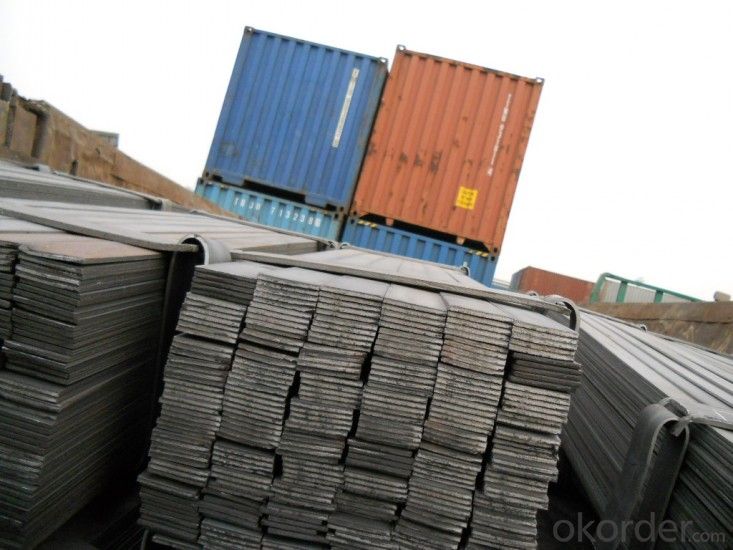
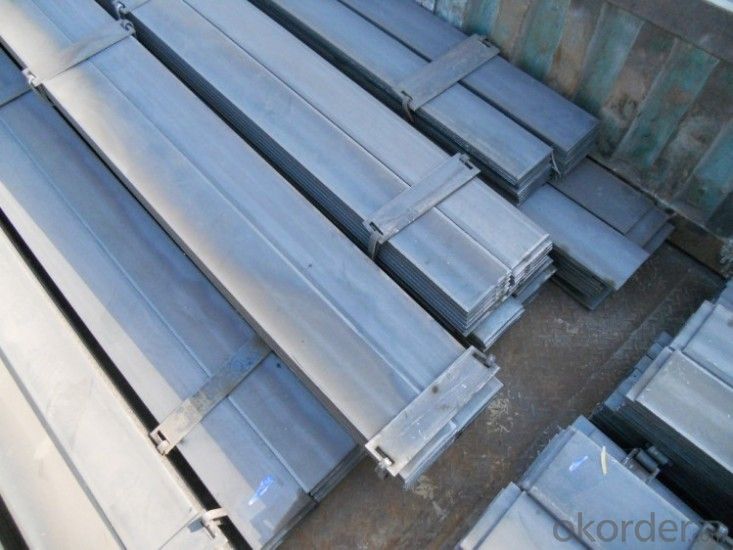
- Q:What is the minimum width of a steel flat bar?
- The specific requirements and standards set by the industry or application can cause the minimum width of a steel flat bar to vary. Typically, the minimum width is around 1/8 inch (3.175 mm). However, it is crucial to consider the specific use case, as certain applications may necessitate narrower or wider flat bars. Moreover, various manufacturers may have their own minimum width specifications for steel flat bars. Consequently, it is advisable to refer to the relevant industry standards or manufacturer guidelines for the specific minimum width requirement in a particular context.
- Q:Are steel flat bars suitable for high-traffic areas?
- Yes, steel flat bars are suitable for high-traffic areas. Steel is a durable and strong material that can withstand heavy foot traffic and other types of wear and tear. It is resistant to bending, breaking, and warping, making it an ideal choice for areas with high footfall such as commercial spaces, walkways, and industrial environments. Additionally, steel flat bars can be designed to have non-slip surfaces, further enhancing their suitability for high-traffic areas.
- Q:What are the different standards for steel flat bars?
- Steel flat bars, also known as steel flats or flats, are available in a variety of standards that determine their size, shape, and composition. These standards are established to guarantee consistency and excellence in the production and utilization of steel flat bars. One highly recognized standard for steel flat bars is the ASTM A36, which outlines the prerequisites for carbon structural steel. This standard specifies the chemical composition, mechanical properties, and dimensional tolerances for steel flats used in general structural purposes. Another frequently used standard is the ASTM A108, which covers carbon steel bars for general applications. This standard categorizes steel flat bars into different grades based on their chemical composition and mechanical properties. For more specialized applications, there are specific standards tailored to different industries. For example, the ASTM A276 is a standard that pertains to stainless steel bars and shapes. Within this standard, there are specific requirements for stainless steel flat bars, including their chemical composition, mechanical properties, and dimensions. In addition to ASTM standards, there are also international standards that govern the production and use of steel flat bars. The most notable one is the EN 10058, a European standard that specifies the tolerances on dimensions and shape for hot-rolled steel flat bars. Moreover, there are regional or national standards that may apply in certain countries. For instance, the JIS G3194 is a Japanese industrial standard that provides specifications for hot-rolled steel flat bars used in general structures. These standards are crucial to ensure the quality, compatibility, and interchangeability of steel flat bars in different applications. Manufacturers, engineers, and users rely on these standards to choose and work with steel flat bars that meet their specific requirements and adhere to industry norms.
- Q:Can steel flat bars be used for decorative purposes?
- Yes, steel flat bars can definitely be used for decorative purposes. Due to their sleek and modern appearance, steel flat bars can add an industrial and contemporary aesthetic to various applications. They can be used to create decorative accents such as railings, trimmings, and ornamental details in both indoor and outdoor settings. Steel flat bars can be easily shaped, bent, and welded to achieve different artistic designs, making them versatile for decorative purposes. Additionally, their durability and resistance to corrosion make them suitable for long-lasting and low-maintenance decorative elements. Whether it's for architectural features, furniture, or artistic installations, steel flat bars provide a visually appealing and functional option for decorative purposes.
- Q:Are steel flat bars commonly used in the construction of sports facilities?
- Steel flat bars are commonly employed in the construction of sports facilities. Their versatility and durability make them suitable for various applications in this field. Structural components like beams, columns, and frames are often made from steel flat bars. These bars are also used to build bleachers, grandstands, and other seating structures due to their strength and stability. Furthermore, they play a significant role in the assembly of equipment such as goal posts, fencing, and netting systems. Overall, steel flat bars are a favored option for constructing sports facilities because of their strength, versatility, and ability to withstand heavy loads and harsh weather conditions.
- Q:Can steel flat bars be used for manufacturing automotive parts or components?
- Yes, steel flat bars can be used for manufacturing automotive parts or components. Steel flat bars are commonly used in the automotive industry for various applications such as brackets, supports, frames, and reinforcements. The high strength and durability of steel make it an ideal material for automotive manufacturing, as it can withstand the heavy loads and demands of the vehicles. Additionally, steel flat bars can be easily machined, welded, and formed into different shapes and sizes, allowing for customization and versatility in automotive component production.
- Q:What are the common industries that use steel flat bars?
- Steel flat bars are commonly used in various industries due to their versatility and strength. Some of the common industries that utilize steel flat bars include construction, manufacturing, transportation, and machinery. In the construction industry, steel flat bars are widely used for structural frameworks, support beams, and reinforcement in buildings, bridges, and other infrastructure projects. They provide stability, durability, and resistance to heavy loads, making them essential components in construction applications. Manufacturing industries also heavily rely on steel flat bars for a wide range of purposes. They are used in the production of machinery, equipment, and tools due to their excellent mechanical properties. Steel flat bars are often utilized in manufacturing processes such as welding, fabrication, and machining, where they can be easily shaped, cut, and manipulated. The transportation sector extensively uses steel flat bars in the construction of vehicles such as cars, trucks, buses, and trains. These bars can be found in the chassis, frames, and support structures of vehicles, ensuring their strength, stability, and safety. Moreover, steel flat bars are commonly employed in the machinery industry. They are utilized in the fabrication of machine components, such as brackets, supports, and frames, due to their high tensile strength and resistance to deformation. Steel flat bars also find application in agricultural equipment, mining machinery, and industrial machinery. In summary, the common industries that use steel flat bars include construction, manufacturing, transportation, and machinery. These industries rely on steel flat bars for their durability, strength, and versatility, making them essential components in various applications.
- Q:50*4 hot dip galvanized flat steel can be used as grounding. How many square feet can be used instead of ground wire?
- You say flat steel grounding, and later said mountain laying, should be interpreted as the lead of the earth pole, grounding project called "zone"
- Q:Can steel flat bars be used for making stairs or handrails?
- Yes, steel flat bars can be used for making stairs or handrails. They are commonly used in construction and fabrication due to their strength and durability. Steel flat bars provide a sturdy and reliable option for creating stable and secure stairs or handrails.
- Q:Are steel flat bars suitable for fabrication of brackets or supports?
- Yes, steel flat bars are suitable for the fabrication of brackets or supports. Steel flat bars offer excellent strength, durability, and stability, making them ideal for providing structural support and stability for various applications. They can be easily shaped, welded, and manipulated to create brackets or supports that can withstand heavy loads and provide reliable support in different industries or construction projects.
1. Manufacturer Overview |
|
|---|---|
| Location | |
| Year Established | |
| Annual Output Value | |
| Main Markets | |
| Company Certifications | |
2. Manufacturer Certificates |
|
|---|---|
| a) Certification Name | |
| Range | |
| Reference | |
| Validity Period | |
3. Manufacturer Capability |
|
|---|---|
| a)Trade Capacity | |
| Nearest Port | |
| Export Percentage | |
| No.of Employees in Trade Department | |
| Language Spoken: | |
| b)Factory Information | |
| Factory Size: | |
| No. of Production Lines | |
| Contract Manufacturing | |
| Product Price Range | |
Send your message to us
Hot Rolled Flat Steel Bar in Grade Q235B
- Loading Port:
- Tianjin
- Payment Terms:
- TT OR LC
- Min Order Qty:
- 25 m.t.
- Supply Capability:
- 10000 m.t./month
OKorder Service Pledge
OKorder Financial Service
Similar products
New products
Hot products
Related keywords

